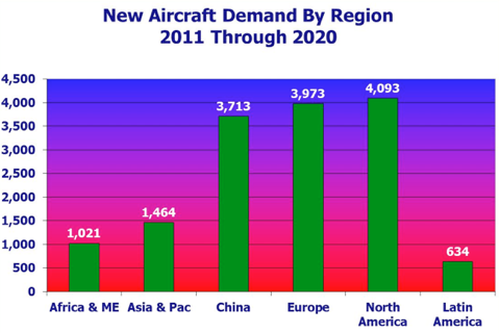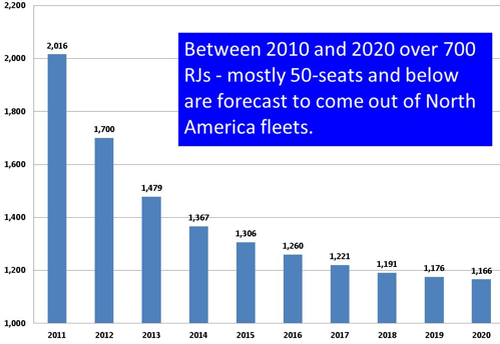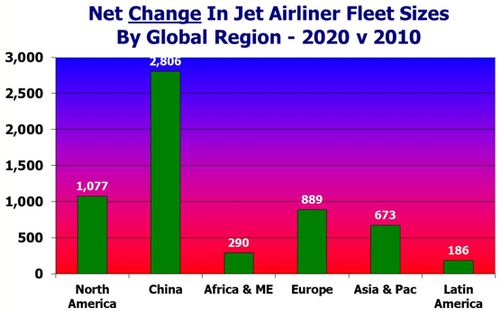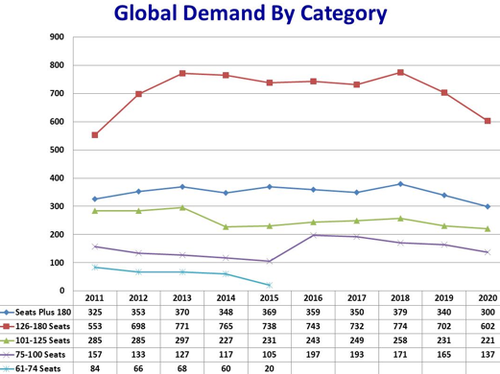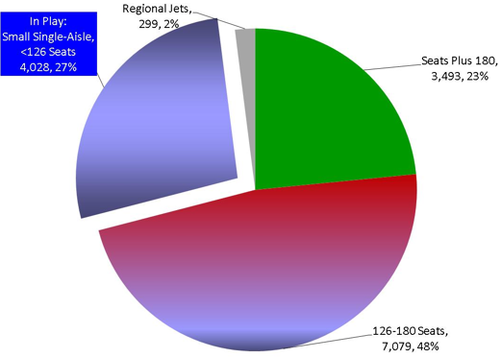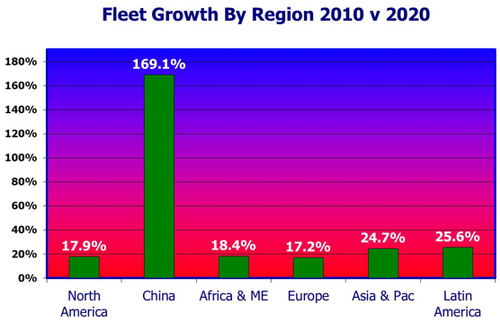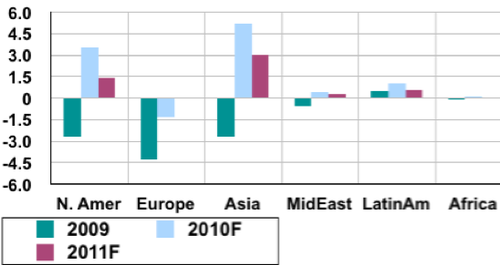Global fleet drivers changing, key metric is flexibility
Given the uncertainty surrounding the future of airlines worldwide, new drivers are changing how airline managements are evaluating their fleet needs, according to Boyd International Group President Mike Boyd. Speaking before the 15th annual International Airline Summit, Boyd said the most important metric now is flexibility, including how fast an airline can spool up or down capacity as the economy changes.
The second key factor is, of course, fuel, which according to ATR Director Marketing and Sales North American Mark Neely is expected to rise to USD100 per barrel by 2020 and USD115 per barrel by 2030.
But the most important thing for manufacturers to know is that alliances will be the ones driving aircraft choice and configuration in the future.
"Inter-alliance fleet pooling will be critical in the future," said Boyd. "Future forecasts will be based on alliance-related imperatives, what alliances will need. There must be complete interchangeability from the cabin to the pilots to the revenue. Where they are going to fly depends more on the revenue that can be made than the passengers they can carry. Decision drivers will start with sector costs, not seat capacity. Mission flexibility will be increasingly important even more so than matching capacity to demand."
And, for that reason, he is calling the Bombardier C-Series a major market disruptor.
Boyd also called China a wildcard. "Everybody knows about China but they don't know much beyond the fact that they are going to need a whole lot of aircraft."
A Demand For 15,000 New Airliners
Boyd said one of the more interesting issues to watch will be aircraft replacements. "They will be replacing one aircraft with the same thing," he noted. "For instance, they'll replace an old A320 for a new one and that's never happened before. Both Air France and Ryan Air have replaced their old equipment - the A320 and 737-800, respectively - with newer versions."
If correct, that could influence whether the manufacturers re-engine their aircraft or wait to produce a clean-sheet design which won't happen until the next decade. That, of course, is what Boeing and Airbus have advocated for the past several years. However, the growing demand of a narrowbody replacement is putting pressure on them for putting something on the market sooner.
The debate is whether or not a re-engined version can achieve the same paybacks that the clean-sheet Bombardier C-Series promises and, of course, Bombardier says no. Boyd agrees with both Boeing and Airbus that airline orders will largely centre on single-aisle aircraft, but added that the capacity bands are contracting, making the Bombardier C-Series the airliner to watch in the next decade. "The widebody share, always smaller, is dropping, and demand for 100-seaters is uncertain, while the 126 to 180-seat aircraft will be the sweet spot."
If Boyd is right that replacements will be the sector watch, then Bombardier is clearly in the right place at the right time, according to the company. "More than half of the current commercial fleet will be replaced in the next 20 years owing to technology obsolescence," said Director of Marketing and Airline Analysis Jerome Cheung. "Most will be replaced by 100 to 140-seat aircraft. In addition, scope will evolve, permitting 100-seat aircraft to be flown by regionals."
Cheung sees the largest market share going to the 100 to 149-seat segments as the current fleet of 5900 aircraft grows to 9000 over the next 20 years. Cheung said this market, alone, offers a USD393 billion total market potential, given the fact it can replace the DC-9, Fokker 100, A319, 737, MD-80 and Avro RJ.
Cheung says the industry is, perhaps, on the cusp of a new age, replacing standard expections of the past. Load factors were typically 70-76% and are now consistently 81.6+%, he pointed out. Similarly, profits were usually non-existent to only USD13 billion compared with the USD20 billion worldwide, according to IATA projections for the September quarter. Capacity growth was normally 2.8-8.3% but is now closer to 1% overall. Orders in the 20 to 149-seat range used to total 200-590 but are now down to 225 year to date, through September, while oil, which has been between 63 and USD103 is now at USD82.29.
Regional jet mission changing
Boyd indicated that even the definition of regional jet has changed. "It is no longer based on short haul, or service to small communities or even capacity," he said. "Atlanta to Denver is not short haul and Houston and Chicago are not small communities. And, if you look at capacity, the CRJ 900 holds more passengers than the DC-9-10s or the BAC-111s. American's F100s had only 87 seats. None of those were called 'regional jets.' Regional jets used to be growth aircraft for regional airlines that were not designed for expansion. Now those airlines are lift lessors and the two basic platforms are the Embraer and Bombardier larger-jet platforms. That means there will be strong demand for the CRJ 900 and 1000 series; more than most people think."
Boyd noted that the current airliners in the 101 to 126-seat market are the A318 and 737-600. "But, you have to remember that perfectly good A318s, less than five years old are being scrapped and the 737 isn't setting any sales records," he said. He questioned the need for the number of 70- to 90-seat airliners with the CRJ 700/900 already on the market. He added projections are overstated. "The 70- to 100-seat category is really already satisfied with the Embraer ERJ 170/190. And there are no viable new replacements on the horizon for the ERJ and CRJ platforms."
Bombardier, of course, sees a need for 2,300 aircraft in the 60- to 99-seat range as well as 3,600 aircraft between 20- and 50-seats.
Insert chart on page 15 of Bombardier presentation -- new opportunities
With a demand for 12,800 regional aircraft units over the next 20 years, regional jet demand will constitute 61% of the market over the next 20 years, with turbroprops taking up the balance at 39%, according to Cheung.
Insert map on page 7 of Bombardier presentation -- geographic distribution
Bombardier fleet forecast 2010 - 2029 20- to 149-seat range, USD12 billion delivery demand
|
Segments |
Fleet 2009 |
Delivered |
Retired |
Fleet 2029 |
|---|---|---|---|---|
|
20- to 59-seats |
3,700 |
200 |
2,600 |
1,300 |
|
60- to 99-seats |
2,200 |
5,900 |
1,100 |
7,000 |
|
100- to 149-seats |
5,300 |
6,700 |
3,000 |
9,000 |
|
20 to 149-seat Total |
11,200 |
12,800 |
6,700 |
17,300 |
USD12bn delivery demand
Boyd expressed real doubts about the 70 to 99-seat market represented by the Mitsubishi MRJ and the Sukhoi SuperJet.
The question will be, said Boyd, whether manufacturers can get sector costs below that of current 70 to 100-seat platforms. He indicated that while some 50-seat markets will not be replaced, the question will then become just how valuable these markets will be as mainline feed. As the aircraft size increases, communities will lose service in favour of Denver-LAX, he concluded.
Indeed, if past is prologue then we could see another wholesale abandonment of regional markets just as we did when the industry transitioned from turboprop to jets. That came when a new layer of safety regulations conspired to increase costs for the industry, just as regional management is facing today. Consequently, the likelihood of abandonment increases.
Boyd also questioned using 50-seats on longer stage-lengths. He indicated that they may not be as economical as larger aircraft on the same route. "In other words, in the US, more outsourcing probably won't go very well," he said.
Chinese aircraft, no chance in the west
He expressed impatience with all the new offerings in the field. "First, let's stop the charade," he said. "The ARJ-21 is a Chinese version of Russia's TU-204, which itself was a copy of the DC-9 and it has no earthly chance of selling except to captive carriers. And it is highly unlikely that the C-919 will have a chance of replacing the A320 at Air France or United so that means its customer base will remain in China. Impressive performance notwithstanding, the MRJ is a very limited growth platform and ditto the SuperJet. Both manufacturers seem to have swallowed funny fleet projections regarding the regional jet.
"The Bombardier C-Series, however," he continued, "may be the single-aisle version of the 787 where the economics invade across the 90 to 150-seat market. It's break-through economics means a wider mission capability and that brings us to what will be needed most in the coming years - maximum fleet flexibility. There is major uncertainty regarding the ultimate production of viable airliners in the 70 to 125-seat range which could result in major up-shifts in unit capacity and changes in airline operational strategies. But, for now, in the single-aisle category, only the C-Series appears to be a disruptive entrant. Boeing and Airbus decisions on new single-aisle aircraft or upgrades will affect demand upward."
Boyd sees a market over the next decade of 17,871 aircraft worldwide. The total fleet will jump 33.1% by the end of 2019, or 5922 aircraft for a total fleet of 23,793. Growth will account for the majority - 59.7% - of the new aircraft at 8894 units, while replacement will account for 40.2% or 6004 units. The total new fleet demand, he said, will be 14,898 units.
Boeing, Airbus weigh in
Boeing Commercial Airplane Director of Business Development Richard Wynne pegs total worldwide aircraft needs at 30,000 over 20 years, much in line with Boyd's 10-year forecast but Boeing's regional jet forecast seems to be higher. Regional cabin jets, according to Boyd, will only be 2% of the world fleet at 299 units at the end of the next decade. However, Boeing indicated that such jets will account for 6% of the world total in 20 years or 1,920 aircraft.
Boeing's economic assumptions include world-wide GDP growth will rise 3.2% over the next 20 years, while the fleet will grow 3.3% and passengers will be up 4.2%. Interestingly, Airbus and Boeing suggest a 4% passenger growth rate, shaving a point off the industry's traditional annual growth rate at 5%. RPKs will jump 5.3% while cargo tonnage will rise 5.9%. Boeing also sees a 69% growth rate for single-aisle aircraft at 21,500 units while wide-body aircraft will have slower growth rate of 23% or 7100 units. Very large aircraft, however, will grow only 2% or 720 aircraft.
For her part, Airbus Director of Airline Marketing Linda Paulson pegged total aircraft need over the next 20 years at a more conservative 24,951 new aircraft, some 16,977 of which will be single aisle. She predicted 27% of the single aisles will go to North American carriers as will 22% of the total units. Naturally, Paulson's forecast is more robust than Boeing's on the large aircraft. Airbus pegs that market at more than double Boeing's prediction at 1,729 units over the next two decades. Only 4% will go to North American carriers, however. Wide bodies will account for 6,245 with 13% destined for North America.
Airbus expects passenger traffic - up 9.2% in July from July 2009 - is growing in line with the 4% world GDP growth rate projected out for the fourth quarter. Airbus' 20-year compound annual growth rate is 4.7% and will double in the next 15 years just as it has in the past, she said.
While India and China may be the fastest growing aviation markets, the US remains the largest market in terms of revenue passenger kilometres, said Paulson. With China as the largest growth market, it will demand new aircraft for its large developing markets, whereas the US will rely more on replacing current single-aisle aircraft which will take up 83% of demand for new aircraft over the next two decades.
India and China fastest growing, but domestic USA remains the largest market
Europe and CIS will require 6969 aircraft. Airbus sees a larger emerging Eastern European/CIS market allowing for steady sustained growth. Still, with Asia as Europe's top market, strongest demand will be in long-haul equipment.
Boyd, however, is predicting that 180-seat-plus aircraft will account for 3493 aircraft or 24.5% of the total over the next 10 years. But the real growth will come in the 100 to 125-seats at 2526 units and 75 to 100-seat jets at 1502 units, which will account for 17% and 10.1%, respectively, of the total worldwide fleet by 2019. His forecast for the 126 to 180-seat market for 7079 jets assumes that there will be no re-design of the A320 or 737.
More is less for North American carriers
Echoing what North American carriers have been saying for at least a year, utilisation will account for the increased seats in that market through 2011. Indeed, growth will be very limited throughout the forecast period at between 2% and 2.5% per year through 2020. Boyd noted that passenger projections agree with that assessment.
Also not surprising was the growth rate Boyd predicted for China which will be 8.9% next year, peaking at 9.1% in 2012. However, the rest of the forecast period shows it steadily declining, still in the 8% range through 2016 with a sharp drop to 5.3% in 2017. Europe will pace North America at slower growth rates throughout the forecast along with Latin America, Africa and the rest of Asia.
ATC won't be able to accommodate aircraft increases
The largest question for both North America and China is whether the infrastructure will be able to keep pace and Boyd holds out little hope. As for the US, its air traffic management system - which Boyd called moribund - will continue to bump along with no real progress while China will probably only get 50 of the 97 airports it has planned. Boyd also questioned whether the EU will allow more aircraft given its stand on cap and trade and reducing aviation demand.
Boyd, however, said that China will move to increase its trans-Pacific footprint at the expense of North American carriers, ultimately coming to dominate the market since its twin-aisle aircraft demand will be twice that of North American airlines. He also reminded the audience that China's goal is to put 80% of the population within 60-or-so miles of an airport which will be unsustainable over the long term.
The North American fleet will have a net change of just 1000 aircraft between now and 2020, said Boyd. "The new airliners will not represent net new growth until 2014 and 2015," he said, adding the biggest change will result from alliances. "Global alliance expansion will afford pooling of equipment which will likely result in greater efficiencies in the twin-aisle fleet. The utilisation will go up which means fewer units will be needed. And, there is nothing on the horizon that will get air traffic management to accommodate those 1000 aircraft." That means delays will continue.
China will experience growth in the small and large-aircraft segments while the US will focus more on the 140-seat range, the sweet-spot for the C-Series, said Boyd, who cautioned the projection assumes manufacturers will rise to meet the demand. At this point, the only game in town is the C-Series and Boyd sees a lot of potential for the aircraft doing alliance work. Here again he said that excess seats won't be as big a factor as excess sector costs.
"The C-Series will disrupt the system and may goad Airbus into upgrading or re-engining the A320," he said. "It is a competitively dangerous aircraft. If you make a new pie chart on the 75 to 190-seat band and the potential players, it means that to be successful you will have to bring the most versatile platform to the market to win. It means a 4000 unit toss up."
New entrants a thing of the past
Boyd echoed the conventional wisdom that new airlines will not pop up, especially in North America, nor will retired airliners come back, especially given the EU stance that older aircraft need not apply because "they've gone bonkers with environmental rules".
"The opportunity for new airlines? Almost zip," he said. "The cheap lease rates do not offset other costs. In other words, the dessert is like Las Vegas. What goes to the dessert, stays in the dessert because there is very little secondary market for retired airliners. The next time you see those aircraft, they'll be a Coke can. In fact, most were retired for economic reasons and that is not going to change. And the 737-300/500? Some 90% of them are with one airline, Southwest. The retired regional jets are like kittens. They're cute but nobody wants them. China is the main growth region and they want new and, in the future, they will get new, from their own domestic manufacturers."
Profitablity outlook improving -- Asia, NA leading, Europe lagging
Boeing's Wynne suggested there were several new drivers acting on the airline industry besides the usual traffic forecast, changing aircraft capabilities, network development and economic growth. Indeed, he pegged governmental policy initiatives as paramount since so much of an airline's fortunes rests on that. Stemming from that, he also pointed to market liberalization, fuel prices, infrastructure, environmental initiatives and high-speed rail as likely issues that could force changes in the forecast. Wynne noted that because of this, airlines are changing their business models and strategy.
He predicted by 2029, emerging business strategies will account for 35% of the industry although today 90% of global traffic is still being carried by traditional network carriers.
"Success depends not only on people, technology, products and service, but also on shaping policy for an industry that accounts for 32 million jobs and accounts for 8% of worldwide GDP," he said. "It has the potential to double those statistics in 20 years, if policy will let it. Policy is rarely neutral. It can support or impede the best business plan."
Wynne went on to discuss the various policy changes that affect the competitive landscape, of course, leading with the current battle between Airbus and Boeing about subsidies before the World Trade Organisation. However, he also pointed to the current row surrounding export subsidies which manufacturers deem critical to sales and airlines see as tilting the playing field against them in an increasingly global market.
He said that current environmental policies will likely limit or distort growth, adding that advancement in bio-fuel technology will likely yield the best results for both airlines and the environment. He also advocated for increasing liberalisation pointing to current efforts of the US with South Korea, Colombia and Panama. Finally, he said that the complexity, waste and cost of current air traffic management systems must be wrung out if airlines are going to continue to grow.
Turboprop comeback
Meanwhile, ATR Vice President Marketing & Sales North America Mark Neely, put forward the case for turboprops saying a decade ago they accounted for only 15% of deliveries. However, in the future turboprops would account for 40% of deliveries to the regional market over the next 20 years, largely driven by fuel costs.
However, in order to be successful they must shed their traditional "ugly duckling" mantel in favor of becoming a long-term solution to regional lift that offers speeds equal to regional jets and much lower operating and seat costs. In an effort to increase the seamlessness of passenger comfort, the company's -600 includes the ability to use jet-bridges for boarding and a forward door.
ATR is projecting a need for 2950 new T-props valued at USD71 billion. "The largest piece of the pie will be 60 to 90-seat units at 1250 units, followed by the 90-plus seaters at 1150 units or 40% of he total," said Neely, who quoted Richard Jones, Deputy Executive Director head of the International Energy Agency as forecasting oil reaching USD100 per barrel by 2020 and USD115 by 2030. "Fuel efficiency favors turboprops. Regional jets have 66% higher fuel consumptions and 55% higher per-seat costs on a typical regional route."
Saying the market is unbalanced in favour of jets, even on routes where new-generation turboprops would be more economic, Neely also noted the strong market potential for turboprops to replace aging regional aircraft. Here again, North America will be the recipient of the most aircraft, needing replacement for 724 aircraft. Latin America, Africa and Australasia would need 160, 208 and 214, respectively, while Europe would need 380.
